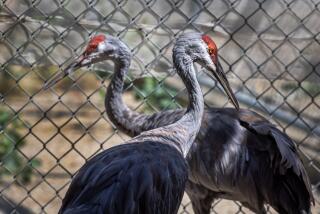Zoo Gets Set for Pandamania as 2 Long-Awaited Visitors Arrive : The Pandas Are Here!
- Share via
Two giant pandas arrived in San Diego from China on Thursday and took up residence in a post-modern panda palace, where they are scheduled to pass the next 200 days sleeping, eating bamboo and bee pollen and taking an occasional bicycle ride.
The specially trained pandas, on loan from the Fouzhou Zoo to the San Diego Zoo, are the only pandas currently on the West Coast. Their visit is aimed in part at stirring support for endangered species like the panda, whose numbers have dwindled to 700 in the wild.
The exhibit, to open Monday, is also expected to increase attendance at the already well-attended San Diego Zoo. The zoo has invested $500,000 in the pandas’ accommodations alone and expects 1.5 million people to see the creatures.
The pandas, a 6-year-old male named Yuan Yuan and a 7-year-old female named Basi, arrived at Los Angeles International Airport on Thursday afternoon after a 10-hour flight from Narita, Japan, in the cargo compartment of a commercial jetliner.
After a brief unveiling for the benefit of media representatives bused in for the event, the pandas were loaded in their cages into a rented van and driven south to San Diego, escorted by the California Highway Patrol and a bevy of zoo officials.
The pandas are to be housed in a specially adapted shelter, formerly inhabited by clouded leopards. To accommodate the zaftig foreign visitors, the zoo widened the doorways and set up separate bedrooms, a kitchen, a pool, European birch trees and hidden cameras.
The kitchen will be used by the pandas’ keepers, two young, Chinese women who will live in trailers nearby. There, they will prepare the pandas’ meals, which include mixed wheats, corn, rice, soybeans, fruit salad, a Chinese “bee byproduct” and, of course, bamboo.
Lots of bamboo.
“It just so happens the headquarters of the American Bamboo Society is in San Diego,” said Jeff Jouett, a zoo spokesman. The pandas are expected to consume 4.5 tons of bamboo during their visit, or about 22 pounds per panda per day.
The pandas, which zoo officials say were rescued from near-starvation and nursed back to health at the Fouzhou Zoo, have been specially trained by their Chinese handlers--an attribute that appeared to leave San Diego Zoo officials slightly squeamish.
“It bends our conservation ethic a bit,” conceded Jouett. While the San Diego Zoo emphasizes “natural behaviors” in its own animal shows, the pandas may be seen pushing a baby stroller, riding a bicycle and slam-dunking a basketball, among other things.
But he said the special training has advantages: The two pandas are unusually comfortable with human contact. Which, Jouett said, means they can be approached without tranquilizers for research functions, such as measuring blood pressure, heartbeat and vital signs.
However, it is unclear how much research will be done with the pandas through the zoo’s Center for Reproduction of Endangered Species. The Fouzhou Zoo director, who will be in California for three months, has agreed to discuss it after the pandas adjust.
Zoo officials would like to explore the pandas’ genetics and hormones, and perhaps take samples of panda semen, Jouett said. They would also like to do some behavioral studies--all “to hedge against their extinction in the wild.”
Jouett said it is unlikely that the pandas willl mate while in San Diego.
Giant pandas are native only to the high mountains of central China, primarily in Sichuan Province. At one time, they ranged throughout most of central and eastern China, according to information supplied by the zoo.
Two giant pandas on loan from China were displayed in Los Angeles and San Francisco in 1984. The only other pandas currently in the United States are two permanently housed at the National Zoo in Washington, D.C., and two on loan to the Bronx Zoo in New York City.
San Diego Zoo officials first approached Chinese officials in 1946 about the possibility of a panda loan, zoo officials said. The Chinese revolution put that effort on hold, and talks resumed in 1979.
Jouett said the zoo agreed in its contract with the China Wildlife Assn. not to reveal the size of the “contribution” it is making to the association in return for the loan. Jouett said both sides hoped to avoid setting a “going rate for pandas.”
The zoo also intends to open a special panda concession stand, selling panda books, posters, pins, buttons, salt and pepper shakers and other paraphernalia. The zoo has 144,000 panda T-shirts and 50,000 stuffed pandas in stock. It is also selling panda fortune cookies.
“Here’s my favorite,” said Jouett, who wrote the fortunes. “A panda in the handa is worth two on the veranda.”
More to Read
Sign up for Essential California
The most important California stories and recommendations in your inbox every morning.
You may occasionally receive promotional content from the Los Angeles Times.










